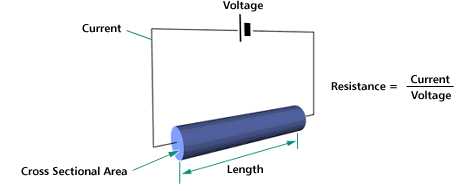Property Information
Resistivity
Overview
- Resitivity is a measure of the resistance to electrical conduction for a given size of material. Its opposite is electrial conductivity (=1/resistivity).
- Metals are good electrical conductors (high conductivity and low resistivity), while non-metals are mostly poor conductors (low conductivity and high resistivity).
- The more familiar term electrical resistance measures how difficult it is for a piece of material to conduct electricity - this depends on the size of the piece: the resistance is higher for a longer or narrower section of material.
- To remove the effect of size from resistance, resistivity is used - this is a material property which does not depend on size.
- Restivity is affected by temperature - for most materials the resistivity increases with temperature. An exception is semiconductors (e.g. silicon) in which the resistivity decreases with temperature.
- The ease with which a material conducts heat is measured by thermal conductivity. As a first estimate, good electrical conductors are also good thermal conductors.
Design issues
- Resistivity is important in any product which conducts electricity. Components which must conduct easily (called "conductors") must have low resistivity, while those which must not conduct (called "insulators") must have high resistivity.
- Many products will contain both conductors and insulators, e.g. a 13A plug - the conductors take the electricity where it is wanted (the machine or appliance) and the insulators prevent it from getting where it isn't wanted (i.e. the user!)
- The resistivity of insulators and conductors differ by a huge factor - typically one million, million, million! Within a given class of materials (e.g. metals), the resistivity can still vary by a factor of 1000 or more. The differences look small compared to the difference between metals and insulators like polymers, but can be very significant in choosing the metal for a conductor - 1000 times more current for the same voltage.
- Electrical and thermal conductivity are closely related. Examples of products in which good thermal conduction is required are radiators and saucepans; thermal insulation is required for pan handles and cookers.
Measurement
Observations of how the resistance varies with size of a sample suggest that resitivity obeys the relationship:
Electrical resistivity = resistance * cross-sectional area / length
The resistivity can therefore be calculated quite easily be measuring the resistance of a piece of wire of constant cross-section and known length.

In practive resistivity is difficult to measure accurately because of the effect of temperature. More sophisticated techniques need to be used if accurate measurements are required, e.g. a Wheatstone bridge.
Units & Values
From the definition of resitivity it can be seen that it has units of ohm-metres. Giving exact values can be difficult because of the strong temperature dependence. Data are usually given for room temperature.



